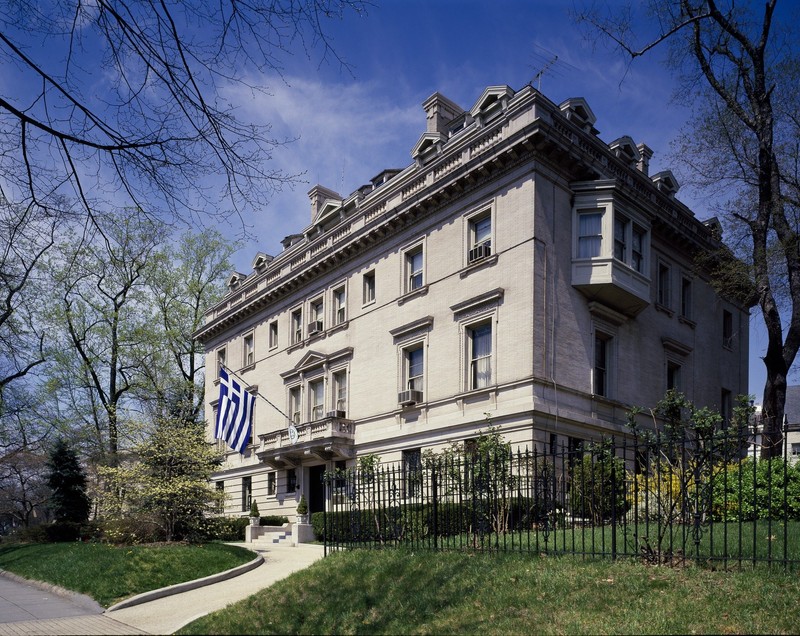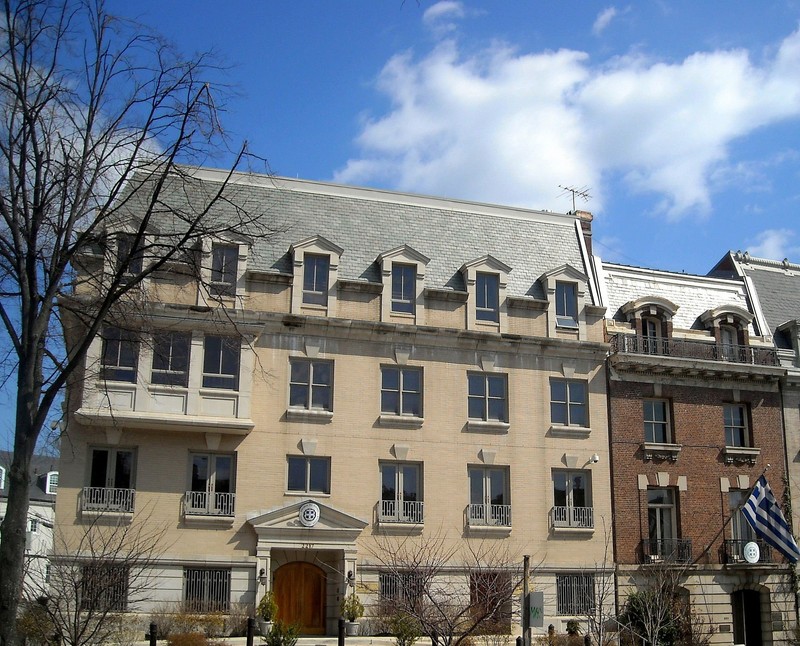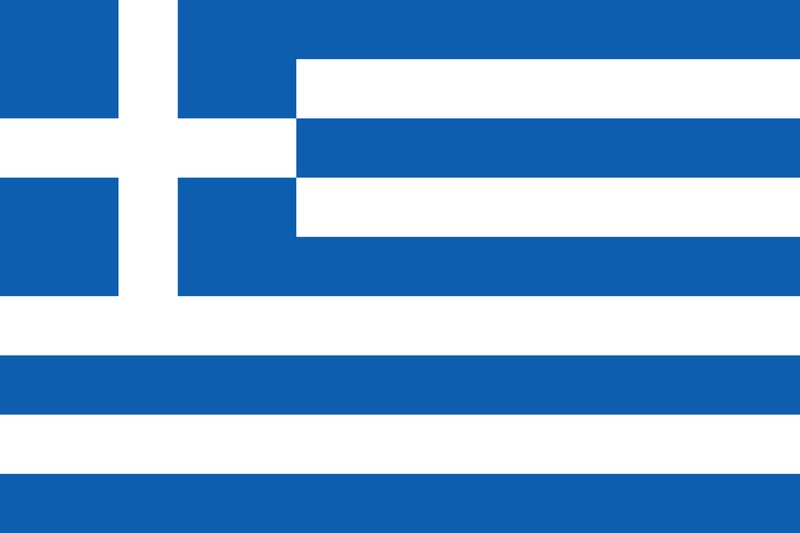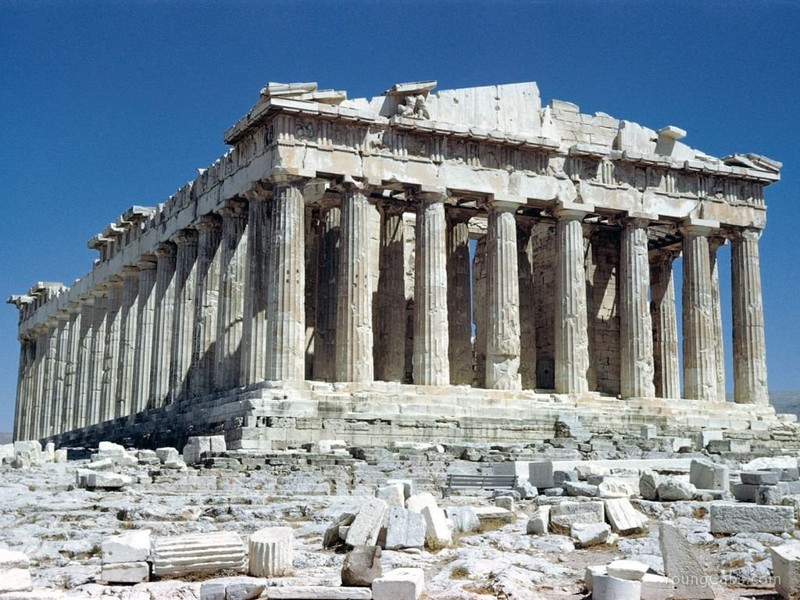Embassy of Greece
Introduction
Text-to-speech Audio
Images
The Greek Embassy's chancery was originally a mansion built in 1906. The embassy moved around D.C. several times until the mansion was given to the Greek government in 1937. Wikimedia Commons.

Two neighboring properties that comprise the Greek Embassy. The building on the left was constructed in 2006 by Greek architect Angelos Demetriou, and the brick building on the right belonged to the wife of Civil War Lt. General Philip Sheridan

The modern Greek flag was adopted in 1978. The cross represents Eastern Orthodox Christianity and colors are symbolic of the Greece's beautiful blue sky and sea. Wikimedia Commons.

The most iconic structure in Greece is the Parthenon, built between 447 BC and 438 BC. The temple was dedicated to Athena, the patron goddess of Athens.

Backstory and Context
Text-to-speech Audio
The Greek Embassy maintains relations with the United States, an important ally for economic development and stability, military support, maritime activities, and engagement with the Muslim world. Greece is a member of the European Union and the North Atlantic Treaty Organization (NATO). The Greek Embassy supports Greek citizens and residents in the United States, providing consultation, and promoting Greek heritage and culture. Greek consulates are also located in San Francisco, Boston, Los Angeles, New York, Chicago, Tampa, Atlanta, and Houston. The chancery in Washington, D.C., built in 1906 and acquired by the Greeks in 1937, tells a longer history of Greeks in the United States.
After an eight-year war for independence, and several centuries of unsteady relations, Greece broke free from the Ottoman Empire in 1832. They had received assistance from European nations including England, where diplomats expressed interest in the United States forging relations with Greece. The United States recognized Greek independence in 1837 and appointed the first consul to Greece, stationed in Athens, the same year. That post became a legation in 1868, formally establishing diplomatic relations between the countries, and rose to embassy status in 1942.
In the United States, the first Greek consulate opened in 1866 in New Orleans, a city home to a significant Greek population. In 1867, a Greek consulate was established in New York City. In the early twentieth century, Greek immigrants lived in all corners of the nation, with large communities in the American West and New England, where they commonly worked in shoe or textile factories. Lowell, Massachusetts was the most important Greek town in New England; the first Greek Orthodox Church in America was established in Lowell. This attracted more and more Greeks to the area, and by 1920, Lowell had one of the largest populations of Greeks, following New York City and Chicago. However, there were large populations in various other cities as well. By World War I, there were substantial populations of Greeks in Philadelphia, Pittsburgh, Buffalo, Cleveland, Toledo, Detroit, and Milwaukee.
The Greek Embassy in Washington, D.C. was established in 1907 as a legation and elevated to an embassy in 1942. Prior to moving to its current location, the Greek Embassy was located on 2020 Columbia Road (now the Wyoming Apartments) and 1838 Connecticut Avenue in Adams Morgan and 2139 R Street in Dupont Circle. The current chancery is a 1906 mansion built by D.C. architect George Oakley Totten for Hennen Jennings, a mining engineer. In 1937, William Helis, a Greek immigrant, purchased the mansion and donated it to the Greek government. The Greek Embassy complex includes two other buildings on Massachusetts Avenue. The larger structure at 2211 Massachusetts was built by Greek architect Angelos Demetriou in 2006. Attached to it at 2217 Massachusetts is the historic Sheridan House, home to Irene Sheridan, widow of Civil War Lieutenant General Philip Sheridan, and the daughter of Civil War Brigadier General Daniel H. Rucker.
Sources
Ancestry.com. U.S. City Directories, 1822-1995. Washington, District of Columbia, City Directories of 1909, 1926, 1932. Accessed November 2017.
The
Building. Hellenic Republic. Accessed April 14, 2017. http://www.mfa.gr/usa/en/the-embassy/history/the-building.html
Mission's History. Hellenic Republic. Accessed
April 14, 2017. http://www.mfa.gr/usa/en/the-embassy/history/missions-history.html.
Greek Diaspora in the USA. Hellenic Republic.
Accessed April 14, 2017. http://www.mfa.gr/usa/en/greece/greece-and-the-usa/cultural-relations-and-greek-community.html?page=....
National Register of Historic Places. “Massachusetts Avenue Historic District.” National Register of Historic Places Inventory-Nomination Form. Washington, D.C.: National Park Service, Department of the Interior, 1974. Accessed November 2017. https://npgallery.nps.gov/GetAsset/3396e30f-4d92-42c3-89da-4d7a81dd6c8c
Parthenon, Athens. Sacred Destinations. Accessed
April 14, 2017. http://www.sacred-destinations.com/greece/athens-parthenon.
U.S. Department of State. "A Guide to the United States' History of Recognition, Diplomatic, and Consular Relations, by Country, since 1776: Greece." Office of the Historian. Accessed October 2017. https://history.state.gov/countries/greece
U.S. Department of State. "U.S. Relations with Greece." Bureau of European and Eurasian Affairs Fact Sheet. October 17, 2016. Accessed October 2017. https://www.state.gov/r/pa/ei/bgn/3395.htm
